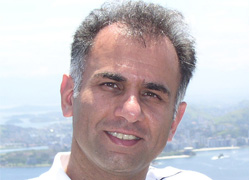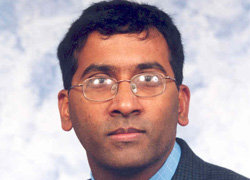IMDEA Networks

Archives: Events
Multipath TCP
Normal TCP/IP operation is for the routing system to select a best path that remains stable for some time, and for TCP to adjust to the properties of this path to optimize throughput. A multipath TCP would be able to either use capacity on multiple paths, or dynamically find the best performing path, and therefore reach higher throughput. By adapting to the properties of several paths through the usual congestion control algorithms, a multipath TCP shifts its traffic to less congested paths, leaving more capacity available for traffic that can't move to another path on more congested paths. And when a path fails, this can be detected and worked around by TCP much more quickly than by waiting for the routing system to repair the failure.
Read more arrow_right_altWireless Mesh Networks: QuRiNet Testbed and Related Research
Wireless mesh networks are becoming popular alternatives to wireless LANs and for cost-effective use in varied application environments. There are several technical challenges that must be addressed for mesh networking to be as effective as any other form of broadband networking. Much of these challenges relate to multi-hop wireless communication and limited capacity. The goal of this informal presentation is to facilitate further discussions on these challenges.
Read more arrow_right_altISP-friendly Swarm-based P2P streaming
Existing Swarm-based Peer-to-Peer Streaming (SPS) applications rely on a randomly connected overlays among peers, which tend to generate a significant amount of costly inter-ISP traffic. To reduce such traffic, localization of overlay connectivity within each ISP has received a great deal of attention as a promising approach for reducing the volume of inter-ISP traffic.
Read more arrow_right_alt
Design and evaluation of interconnecting structured peer-to-peer networks with a hierarchical topology
This talk gives an overview on how different overlay networks can share information among them and some recent results based on an implementation tested on an emulation environment are given.
Read more arrow_right_altMonitoring and Managing the Quality of Service in Structured Peer-to-Peer Systems
The peer-to-peer paradigm shows the potential to provide the same functionality like client/server based systems, but with much lower costs.
One substantial limitation of p2p systems are missing guarantees on the quality of service, as the whole infrastructure is based on unreliable peers. In order to control the quality of peer-to-peer systems, monitoring and management mechanisms need to be applied. Both tasks are challenging in large-scale networks with autonomous, unreliable nodes.
Read more arrow_right_altDeep Diving into BitTorrent Locality
A substantial amount of work has recently gone into localizing BitTorrent traffic within an ISP in order to avoid excessive and often times unnecessary transit costs. Several architectures and systems have been proposed and the initial results from specific ISPs and a few torrents have been encouraging. In this work we attempt to deepen and scale our understanding of locality and its potential. Looking at specific ISPs, we consider tens of thousands of concurrent torrents, and thus capture ISP-wide implications that cannot be appreciated by looking at only a handful of torrents. Secondly, we go beyond individual case studies and present results for the top 100 ISPs in terms of number of users represented in our dataset of up to 40K torrents involving more than 3.9M concurrent peers and more than 20M in the course of a day spread in 11K ASes. We develop scalable methodologies hat permit us to process this huge dataset and answer questions such as: What is the minimum and the maximum transit traffic reduction across hundreds of ISPs? What are the win-win boundaries for ISPs and their users? What is the maximum amount of transit traffic that can be localized without requiring fine-grained control of inter-AS overlay connections? What is the impact to transit traffic from upgrades of residential broadband speeds?
Read more arrow_right_altProviding Throughput Guarantees in Heterogeneous Wireless Mesh Networks
This talk addresses the problem of providing throughput guarantees in heterogeneous wireless mesh networks. As a first step, it proposes a novel model to represent the capacity region of a wireless link that, by linearizing this region, has the fundamental property of being very simple while providing a good approximation to the entire region. In a second step, this model is mapped to two of the most prominent wireless technologies nowadays, namely Wireless LAN and WiMAX. The last step addresses the issue of finding optimal routing strategies, which is done by solving an optimization problem subject to the constraints imposed by the linearized capacity region. The performance of the proposed approach has been compared against traditional routing metrics in mesh networks, such as ETT and ETX, and shown to overperform them by approximately a factor of 2.
Read more arrow_right_altMultipath TCP and the perils of redesigning the Internet
The way the Internet works today is that routing protocols select a single path through the network, and transport protocols like TCP then adapt to the properties of that path. So the situation where there are unused paths that remain idle is quite common. The idea behind multipath TCP is to modify TCP so it can send packets over multiple paths at the same time, moving traffic from more congested paths to less congested paths and thus optimizing network utilization and performance.
Read more arrow_right_altMobility – Background, State-of-the-art, Challenges and Approaches
Mobility is, without doubt, one of the major new paradigms of the current Internet, and this is driving most of the research activity in networking throughout the World. We are gradually evolving from a network where most end-systems have a fixed or quasi-fixed point of attachment, towards a global network where end systems seamlessly move from network to network and where networks themselves change their connection point to the Internet. In spite of this there is still a long way to go before user and network mobility – at IP level – become a reality, as several technological and research challenges persist.
Read more arrow_right_altDesign and Evaluation of a robust delay-based congestion protocol
Many delay-based congestion protocols have been proposed. Some recent studies have questioned the validity of congestion prediction at end hosts Based on measurement studies. In this talk, we show that end-host based delay prediction can be more accurate than previously characterized. We propose PERT (Probabilistic Early Response TCP) to mitigate the uncertainties in end-host based congestion prediction. PERT emulates the behavior of AQM/ECN in the end hosts' response to congestion.
Read more arrow_right_alt











Recent Comments